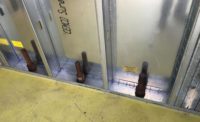The exterior vertical surfaces of a home can take a beating. But in today’s climate of increasing construction-defect lawsuits, that “beating” can extend right to the contractor’s business. Stronger defenses must be adopted, and they begin with a reexamination of existing exterior coating options available.
Hail, woodpeckers, baseballs, errant golf balls, rocks kicked up by weed whackers and lawn mowers, earthquakes, debris damage from hurricanes and tornados and even normal thermal cycling, wind shear and “settling” all serve to crack, pit, ding, and erode the protective exterior coating of residential homes.
Once compromised, the damaged exterior invites an even more destructive element: Water. Once inside the protective outer barrier, moisture leads to further exterior damage, rot, mold, termites and more.
With all the threats to a structure’s exterior, homeowners deserve a coating that can essentially serve as a structural “suit of armor” against all types of damage, regardless of the underlying layers.
However, with the proliferation of foam-based exterior systems, in many cases protective coating has become softer overall, partly because of thinner applied exterior layers that measure as little as half the width of a penny. Having a tough exterior coating—in fact the toughest exterior possible—has distinct advantages for both homeowner and builder/contractor.
For builders and contractors, installing a tough-as-nails exterior coating delivers its own benefits: Little to no long-term maintenance, reduced liability related to breaches in the exterior, happier long term clients and the inevitable word-of-mouth (and future business) that a job well-done generates.
Tough Exterior
Today’s market now offers tough building materials.
A good balance of overall cost and sheer toughness is the PermaCrete system. Not quite a newcomer to the market but an increasingly adopted option if only because of its strength-to-cost ratio. At an installation price comparable to conventional three-layer stucco, this option represents one of the strongest, most durable coating products available.
Independent impact tests show that the product meets the requirements for ultra high impact resistance of 220 in-lbs at a typical 3/8-inch application?enough to be “bullet resistant” at the outer surface, with only minimal cosmetic damage. In comparison to other common building and finishing materials, other tests show that many other options are only 50 percent as strong, with most well below that number.
One of the primary reasons for the product’s strength is it contains 70 to 100 percent more Portland cement coupled with a proprietary bonding agent.
“If you can install a surface that is hard enough that you can prevent, or at least greatly reduce, impact damage and avoid those kind of repair issues, that is a great benefit,” says Glen Cruzen, of Master Stucco, in Nashville, a company that has specialized in stucco repair for the past 20 years.
It’s in the Details
The PermaCrete vertical system is comprised of a Matrix Mix (polymer modified cement) which is mixed with a proprietary bonding additive that increases durability and adherence; fiber mesh; and a sealer that can be clear or tinted. It can be applied by hawk and trowel or spray gun to many substrates, including concrete, masonry, foam, steel, stucco and aggregate. Use of the product helps a contractor accumulate LEED points due to the fact that is contains no VOC’s (volatile organic compounds).
The system is available in hundreds of colors, including color codes from major commercial paint manufacturers, as well as in various patterns and textures.
Jim Huffman, owner of Concrete Rescue (Roanoke, Va.), a company that specializes in repairing aged and damaged concrete surfaces, has seen the product’s toughness up close. He regularly uses it both for overlayment and vertical surfaces.
Huffman recalls a major storm with golf-ball size hail that came through a local lakeside resort area several years ago. He was called in to inspect and repair any damage that might have occurred to one of the buildings.
“Every house exterior in the neighborhood was beaten to a pulp,” says Huffman, who documented the damage to various homes with his camera. However, he found only minimal damage to the single home clad in PermaCrete.
“That house only had very small dings on the edges of the moldings around several windows,” says Huffman. He was able to complete the minimal repairs in little over an hour.
To prove its durability over synthetic and conventional stucco, contractors have improvised a variety of unique demonstrations to show customers, ranging from shooting nail guns at the surface from close distance, throwing a baseball at the wall, and even pounding on it with a hammer.
For Shane Olivarez of Certified Concrete Designs (Rochester, Ind.), a company that does horizontal and vertical applications across the United States, putting this over a product like ICF makes for a product that, with a proper roof, could withstand an F5 tornado.
“It might suck the windows out of it, it might pull the doors off, but your structure will still be there,” says Olivarez.
As far as the contractor is concerned, getting served a complaint for a construction defect lawsuit is like getting slammed by an F5 tornado. All the more reason to seek the toughest protection available.

















